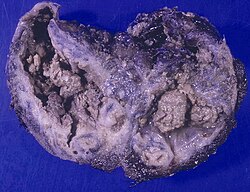Aspergilloma
Editor-In-Chief: Prab R Tumpati, MD
Obesity, Sleep & Internal medicine
Founder, WikiMD Wellnesspedia &
W8MD medical weight loss NYC and sleep center NYC
| Aspergilloma | |
|---|---|

| |
| Synonyms | Mycetoma, Fungus ball |
| Pronounce | N/A |
| Specialty | N/A |
| Symptoms | Cough, hemoptysis, shortness of breath |
| Complications | Massive hemoptysis, respiratory failure |
| Onset | Variable |
| Duration | Chronic |
| Types | N/A |
| Causes | Aspergillus species, commonly Aspergillus fumigatus |
| Risks | Tuberculosis, chronic obstructive pulmonary disease (COPD), sarcoidosis, cystic fibrosis |
| Diagnosis | Chest X-ray, CT scan, sputum culture |
| Differential diagnosis | Tuberculosis, lung cancer, bronchiectasis |
| Prevention | N/A |
| Treatment | Surgical resection, antifungal medication |
| Medication | Itraconazole, Voriconazole |
| Prognosis | Variable, depends on underlying condition |
| Frequency | Rare |
| Deaths | N/A |
Aspergilloma is a medical condition characterized by the formation of a fungal ball (mycetoma) within a pre-existing cavity in the lung. This condition is primarily caused by the fungus Aspergillus species, most commonly Aspergillus fumigatus.
Etiology
Aspergilloma is not a primary infection but occurs when the Aspergillus fungus colonizes an existing cavity in the lung. These cavities may be the result of previous lung diseases such as tuberculosis, sarcoidosis, or lung abscess. The fungus forms a tangled mass, often described as a "fungus ball," within the cavity.
Clinical Presentation
Patients with aspergilloma may be asymptomatic or may present with symptoms such as chronic cough, hemoptysis (coughing up blood), and weight loss. Severe hemoptysis can be life-threatening and requires immediate medical attention.
Diagnosis
The diagnosis of aspergilloma is often made by imaging studies such as chest X-ray or computed tomography (CT) scan of the chest, which may show a characteristic "air crescent sign." This sign is a radiolucent crescent surrounding a radiodense mass within a cavity. Laboratory tests, including fungal cultures and serology, can also support the diagnosis.
Treatment
The treatment of aspergilloma depends on the patient's symptoms and overall health status. Asymptomatic patients may be managed with watchful waiting. For symptomatic patients, antifungal medications such as voriconazole and itraconazole may be used. In severe cases, surgical removal of the aspergilloma may be necessary.
Prognosis
The prognosis of aspergilloma varies widely and depends on the patient's overall health status, the presence of underlying lung disease, and the severity of symptoms.
See Also
Transform your life with W8MD's budget GLP-1 injections from $125.
W8MD offers a medical weight loss program to lose weight in Philadelphia. Our physician-supervised medical weight loss provides:
- Most insurances accepted or discounted self-pay rates. We will obtain insurance prior authorizations if needed.
- Generic GLP1 weight loss injections from $125 for the starting dose.
- Also offer prescription weight loss medications including Phentermine, Qsymia, Diethylpropion, Contrave etc.
NYC weight loss doctor appointments
Start your NYC weight loss journey today at our NYC medical weight loss and Philadelphia medical weight loss clinics.
- Call 718-946-5500 to lose weight in NYC or for medical weight loss in Philadelphia 215-676-2334.
- Tags:NYC medical weight loss, Philadelphia lose weight Zepbound NYC, Budget GLP1 weight loss injections, Wegovy Philadelphia, Wegovy NYC, Philadelphia medical weight loss, Brookly weight loss and Wegovy NYC
|
WikiMD's Wellness Encyclopedia |
| Let Food Be Thy Medicine Medicine Thy Food - Hippocrates |
Medical Disclaimer: WikiMD is not a substitute for professional medical advice. The information on WikiMD is provided as an information resource only, may be incorrect, outdated or misleading, and is not to be used or relied on for any diagnostic or treatment purposes. Please consult your health care provider before making any healthcare decisions or for guidance about a specific medical condition. WikiMD expressly disclaims responsibility, and shall have no liability, for any damages, loss, injury, or liability whatsoever suffered as a result of your reliance on the information contained in this site. By visiting this site you agree to the foregoing terms and conditions, which may from time to time be changed or supplemented by WikiMD. If you do not agree to the foregoing terms and conditions, you should not enter or use this site. See full disclaimer.
Credits:Most images are courtesy of Wikimedia commons, and templates, categories Wikipedia, licensed under CC BY SA or similar.
Contributors: Prab R. Tumpati, MD


